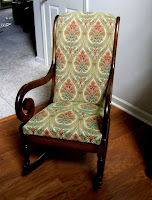An attractive way to carry hand sanitizer. Here is an easy tutorial to make these cute accessories. Attach them to their backpacks or carry on your purse. They can attach to anything the strap can get around. Make the strap longer and they can carry it around their neck. ha, ha, ha. Well, that might not be so funny during flu season.
Any woven fabric will work especially from your scrap pile. Choose a favorite print or for boys, use their favorite team fabric. Guess I'll be making one for Shawn out of Bulldog fabric.
All measurements are for the bottle I am using. You may need to adjust based on your bottle.
You will need:
-One piece fabric 6 1/2" x 4 1/2" cut on the fold (long edge on fold)
-One strip fabric 3" x 7" (longer if you want your strap longer)
-Elastic - I use foldover elastic but feel free instead to make a casing and use 1/8" to 1/4" elastic. This needs to be long enough to really snuggly wrap around your bottle.
-Magnetic snap or velcro, or if you prefer just to use a tie, cut two pieces 2" wide and however long you want your ties. Or, use a pretty ribbon.
1) Cut your fabric pieces.
2) Attach foldover elastic or stitch casing based on the width of your elastic and insert elastic taking at ends.
3) Skip this step if using ties. On strap fabric, install magnetic snap or stitch velcro pieces kitty-corner, measuring 1/2" from the edges.
4) Fold strap right sides together and stitch a 1/8th" seam down the long side. Turn right-side out and press.
5) Tuck remaining raw ends in and slip-stitch closed.
6) Baste strap to one long, raw edge close to the elastic. This will be sandwiched and stitched between the side seam. Stitch closed long edge and finish edges if desired (serge or zig-zag).
7) Center seam in middle and stitch bottom closed. Finish seam if desired.
8) Optional: You can mitre the corners for a more boxy look. Simply flatten out a corner and stitch 1/4" from point. These are so small that if they are slightly imperfect it will be hardly noticeable.
There it is!
But nothing is really finished in craft land until it is embellished, decorated or enhanced in some exciting way. So, I added a flower. I'll do that tutorial later but there are some out there already if you can't wait.

Finally, here it is on my bag.
Let me know if you have any questions and comments are always welcome!

















































